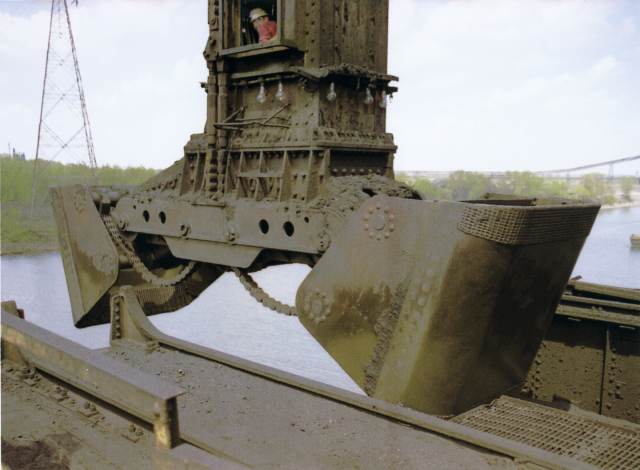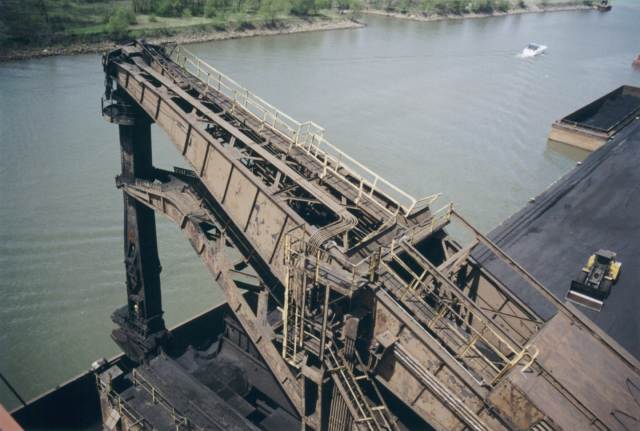THE TIMES of Northwest Indiana
Sunday, June 2, 2002
Last of the giants
COAL MOVER -- Two Huletts at LTV's Chicago coke Plant removing coal from barge on the Calumet river on May 5, 2000. The Huletts are the only two in the world that remain operable.
LTV's Huletts are the only two still intact, and a Cleveland group is trying to save them.
There were once more than than 70 massive Huletts peppering the waterways from Erie to Chicago.
For almost a century, the 880-ton machines -- 10-story, iron praying mantises that look like worthy adversaries of Godzilla -- used their 17-ton buckets to clear barges of iron ore and coke, moving in hours what it took a crew of men a week of back-breaking labor to shovel.
But as steel production slowed after World War II -- and as companies consolidated and, in the 90s, began to shut down the number of operating Huletts dwindled.
Today, there are only two operable Huletts left in the world -- the Chicago machines owned by the bankrupt LTV Corp.
And a group from Cleveland is trying to save them.
The Cleveland-based "Save the Huletts" campaign is looking for Chicago supporters, but it's not easy.
"Huh?" is one typical response to the crusade by those outside the integrated steel industry, said Steve Merkel, vice-chairman of the volunteer organization. Another is, "What the heck are Huletts?"
The Huletts with their 17-ton buckets moved the same amount of ore in an hour that it took men a week to shovel from a ship's hold, thus improving ore delivery and automating the formerly tedious, backbreaking work.

A 17-TON BITE -- A Huletts’ 17-ton-capacity bucket and the operator in its cab in the digging leg ready to pick up coal from a barge and move it on shore at LTV Corp.’s Chicago coke plant on May 5, 2000.
Because of their historical significance, the "Save the Huletts" campaign has been underway in Cleveland since the late 1990s and its organizers -- The Friends of the Hulett Ore Unloaders and Steamer William G. Mather, a committee of Ohio-based Citizen's Vision -- are now hoping it spreads to Chicago.
"Our concentration is on the Huletts in Cleveland,'' said Ray Saikus, a member of the Cleveland campaign. "We hoping someone in Chicago will pick up the ball for the ones in Chicago.''
At one time there were 75 Huletts operating along the shores of the Great Lakes. Only four remain, two in Cleveland and two in Chicago. The rest of the hulking machines have been destroyed.
The last six operable machines were used by LTV Corp.'s Cleveland Steel Works until 1992 and at the bankrupt company's Chicago Coke plant until it ceased making steel in late December. Two of the four in Cleveland were demolished in 2000 and the other two decommissioned, leaving the two in Chicago the only Huletts in the world that remain intact.
"Cleveland's were built in 1912 and put in service in 1913," Saikus said."The ones in Chicago (which were used to unload coal) were built in the 1950s. Their designs are almost identical."

VIEW FROM THE TOP -- The 880-ton Hulett uses its power to move coal from a barge on the Calumet river. The coal was used to make coke for LTV's iron making operation.
Although they were too late to save the two wrecked machines, the Cleveland group has had their four local Huletts are listed in the National Registry of Historic Places, designed as a City of Cleveland landmark and have been honored by the American Society of Mechanical Engineers. And they're attempting to do more. They have raised $250,000 of the millions it will take to restore those that were dismantled and move them to a new location.
And in an effort to keep the Chicago Huletts from being destroyed they have petitioned the federal bankruptcy court hearing the LTV's Chapter 11 case to preserve the two Chicago Huletts, their associated equipment and structures "until appropriate disposition of them can be made in keeping with their historical significance," according to the court filing.
"These Huletts operated on a full-time schedule until the final plant shut down at the end of 2001," the motion says. "If the Chicago coke plant is not restarted, these historic machines are in jeopardy of being lost forever. Because of their historical significance, they, like the Cleveland Huletts, would be eligible to be listed on the National Register of Historical Places and could possibly become a National Landmark."
The committee's motion, filed by it's vice chairman Stephen L. Merkel, claims the cost of demolishing the Huletts is likely to exceed the scrap their scrap value, that they don't interfere with the current use of the closed plant; they don't pose an environmental hazard; they don't pose a navigational hazard to the waterway or to aircraft and their preservation is in the public's interest.
The company has filed an objection to the petition. It claims the committee has no legal standing or any legal justification for its request and it refutes the committee's claims.
But Merkel said he's not upset or discouraged about the company's objection.
"The purpose of the motion is also to create awareness and it's done that," he said. "They can object but the awareness is out there."
LTV, which with the exception of the coke plant, sold most of its steelmaking assets to International Steel Group in April, couldn't be reached for comment. but there were no offers for the coke plant in the bankruptcy sale.
Richard Dowdell, trustee and unit chairperson for Local 1011, United Steelworkers of America at the Chicago coke plant, said saving the Huletts is "the proper thing to do."
"If they're not going to operate the plant, they should preserve them (Huletts)," he said. "They're operable and can be used. But if they're not going to be used -- and it's the opinion of the union -- they should not be scrapped out."
"The coke plant and its batteries, the brick-lined ovens where the coke is made from coal, are in good shape and, because the ovens were cooled slowly and carefully, still can be used," Dowdell said.
The bankruptcy court hasn't ruled on either motion.
In the meantime, the Cleveland committee is trying to stir up interest in Chicago for the Huletts. Merkel, who has a family interest in the project, is trying to find sponsors to lead the effort there.
"How could I not get involved," he said explaining Addie Hutchins Hulett, George Hulett's wife, is his wife and sister-in-law's great aunt. "I've.been involved in the organization in Cleveland and we knew there were Huletts in Chicago still operating so in May 2000 we (he and members of the committee) visited the plant where we took photos and videos."
Merkel and his group have contacted the Chicago Museum of Science and Industry, the Illinois Historic Preservation Agency and the Chicago Historical Society for assistance in their quest.
"We've been trying to get Chicagoans interested in the property and the historic machines," Merkel said. "Their first response is, 'What's a Hulett?', and, 'Where are they?'"
The Museum of Science and Industry responded that the machines are just too big for its collection, Merkel said. The Illinois Historic Preservation Agency's staff showed an interest and were sent information on the project, but haven't responded, he said.
Peter Alter, historian at the Chicago Historical Society, said the Huletts "are immense and expensive and something we don't have the funding to help with."
"We're interested in the history of the Southeast side and the steel industry but we have some more manageable artifacts," he said. "We're interested in doing oral histories of the steel industry there, but other than that it's difficult for us to be involved. We're on a limited budget and it's beyond our capabilities. Most non-for-profits don't have that kind of money."
Although the committee's only estimated the cost of preserving the two dismantled Cleveland Huletts, Merkel said saving those in Chicago will probably cost about the same.
"We figure it will be about $3-$5 million for the pair," he said. "A lot depends on where they go because transportation is a good part of the cost."
The committee isn't disappointed by its lack of progress in the Windy City.
"It's not disappointing," Merkel said. "The people in Chicago need to get familiarized with what these things are and their historical significance."